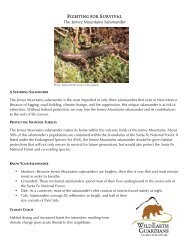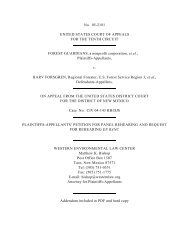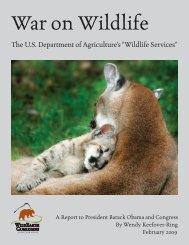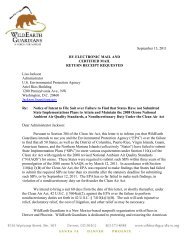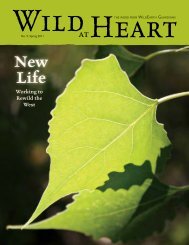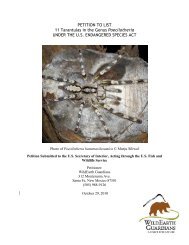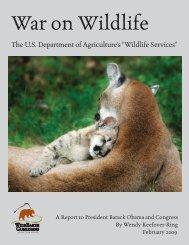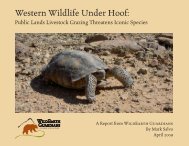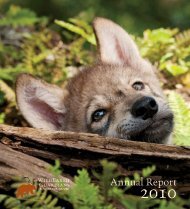here - WildEarth Guardians
here - WildEarth Guardians
here - WildEarth Guardians
Create successful ePaper yourself
Turn your PDF publications into a flip-book with our unique Google optimized e-Paper software.
the word from Wil dEar t h Gu a r d i a n s<br />
No. 3, Spring 2009<br />
Secrets of the<br />
Sagebrush Sea<br />
page 8
Mi s s ion Stat e m e n t<br />
WildEa r t h Gua r d i a n s protects and restores<br />
the wildlife, wild places, and wild rivers<br />
of the American West.<br />
Bo a r d o f Directors<br />
Peter Schoenburg, President<br />
Robin Smith, Vice President<br />
Thomas H. Noble, Secretary<br />
Shannon Larsen, Treasurer<br />
Jess Alford<br />
Bobby Clark<br />
Stephanie Forrest<br />
Dave Jones<br />
Mark Rickman<br />
Jon Spar<br />
Sta f f<br />
Whitney Bacon, GIS Specialist/IT Gu r u<br />
Bryan Bird, MS, Wild Pl a c e s Program Di re c t o r<br />
Rosie Brandenberger, Co m m u n i c a t i o n sDi re c t o r<br />
Lori Colt, Office Ma n a g e r<br />
Rob Edward, Carnivore Recovery Di re c t o r<br />
Melissa Hailey, Sta f f At t o r n e y<br />
John Horning, Ex e c u t iv e Di re c t o r<br />
Mona Kay, Fi s c a l Ma n a g e r<br />
Wendy Keefover-Ring, MA, Carnivore Pr o t e c t i o n<br />
Di re c t o r<br />
Jim Matison, Re s o r at i o n Pr o j e c t s Di re c t o r<br />
Lauren McCain, PhD, Desert a n d Gr a s s l a n d<br />
Pr o j e c t s Di re c t o r<br />
Michelle Miano, Development As s o c i ate<br />
Jeremy Nichols, Cl i m a te & En e r g y Program<br />
Di re c t o r<br />
Duncan North, Cr e at iv e Di re c t o r<br />
Carol Norton, As s o c i ate Di re c t o r<br />
Nicole Rosmarino, PhD, Wildlife Program<br />
Di re c t o r<br />
Mark Salvo, JD, Sa g e b r u s h Sea Ca m pa ig n<br />
Di re c t o r<br />
Rebecca Sobel, Co n s e r vat i o n Or g a n i ze r<br />
Jay Tutchton, General Co u n s e l<br />
WildEa r t h Gua r d i a n s is a 501(c)(3)<br />
tax-exempt organization.<br />
Sa n ta Fe Office:<br />
312 Montezuma<br />
Santa Fe, NM 87501<br />
Tel 505.988.9126<br />
Fa x 505-989-8623<br />
www.wildearthguardians.org<br />
Satellite Offices:<br />
Denver, Phoenix, Oakland, Bozeman<br />
Co v e r: John Carlson<br />
2<br />
100 percent recycled, 50 percent PCW<br />
Restoring the Vision<br />
John Horning<br />
T<strong>here</strong> are moments in the life of every self-identified westerner when you<br />
become not just a citizen of a nation, or a state, but also of a particular<br />
landscape. For me, one of those moments occurred when I was visiting Hart<br />
Mountain National Antelope Refuge in eastern Oregon in the early 1990s.<br />
On that visit I was filled with the sights and smells of the Sagebrush Sea.<br />
I remember hundreds of gangly-legged pronghorns bouncing across the<br />
horizon, a horizon filled with the unbroken olive-green of sagebrush. I had<br />
never known a place so naked, so wild, so big and seemingly so resilient. My<br />
sense of citizenship was renewed and expanded by that experience.<br />
Though I left with a lasting impression of fertility, abundance and intactness,<br />
the reality on the ground was just the opposite. New and mounting threats<br />
continue to tear at the tapestry of life that enriches the Sagebrush Sea.<br />
One of the most endangered and iconic residents of the Sagebrush Sea is the<br />
beautiful greater sage grouse. Under the leadership of Mark Salvo, our Sagebrush<br />
Sea Campaign has a bold vision, not only to secure federal protection for the species,<br />
but also to create a large system of reserves that would protect millions of<br />
acres for sage-grouse and other wildlife. We are also working to pass legislation<br />
to retire grazing permits since grazing poses a major threat to the landscape.<br />
Realizing our vision will not be easy given the political challenges of protecting<br />
the millions of acres of Sagebrush Sea and its iconic species. Fortunately,<br />
because Mark is a trusted coalition builder, conservationists are counting on<br />
Wi l dEa rt h Gua r d i a n s to provide the cohesive leadership required to meet<br />
these challenges. This means Wi l dEa rt h is leading the way to protect and<br />
restore the West’s expansive Sagebrush Sea.<br />
guardian giver<br />
Roxy Hills<br />
y relationship with<br />
“M Wi l dEa rt h Gua r d i a n s is<br />
rewarding because of the warmth and<br />
determination we share in protecting<br />
the wild,” says Roxy Hills, who joined<br />
Wi l dEa rt h Gua r d i a n s last year, but<br />
has been involved in the conservation<br />
movement for a long time. Roxy, who<br />
lives in Oregon, credits her grandmother’s<br />
understanding of nature to<br />
Pictured above is a jar from Roxy’s ceramic<br />
business, Cano;y Ceramics. Proceeds from<br />
her sales benefit Wi l dEa rt h Gua r d i a n s.<br />
helping form her own values with<br />
regard to the wild. “She had a great<br />
respect for wildlife,” she says.<br />
Roxy is now an active member<br />
of Wi l dEa rt h Gua r d i a n s, and notes,<br />
“the personal attention of this group<br />
gives me inspiration to keep going.<br />
It has to be a symbiotic relationship,”<br />
she continues.<br />
Roxy has taken many extra steps<br />
to guarantee the ongoing financial<br />
stability of Wi l dEa rt h Gua r d i a n s,<br />
including joining the organization’s<br />
Diversity of Life Society, a planned<br />
giving program. Planned giving<br />
ensures that the West’s wildlife and<br />
wild places are protected for<br />
generations to come. Roxy took<br />
another step by starting a new<br />
business called Canopy Ceramics.<br />
All proceeds from her sales, after<br />
expenses, will support conservation<br />
advocacy.
stump an enviro!<br />
Dear Blowing in the Wind,<br />
Wind farms are good for the environment<br />
because they are renewable energy and they<br />
don’t create greenhouse gasses – which lead<br />
to global warming and the potential<br />
destruction of all life on the planet. On the<br />
other hand, wind farms can fragment wildlife<br />
habitat and frighten little birds, like the lesser<br />
prairie-chicken. These birds avoid tall<br />
structures because they think big birds, which<br />
like to eat little birds, hang out in everything<br />
tall (like wind turbines, basketball players<br />
and trees).<br />
The simple solution, according to many<br />
environmentalists, is the responsible<br />
placement of wind farms. However, that’s like<br />
saying the simple solution to teen pregnancies<br />
Duncan North<br />
Dear Duncan,<br />
I support renewable energy, but I’m worried that wind farms have a negative impact on<br />
wildlife. Are wind farms bad for the environment?<br />
Thanks,<br />
Blowing in the Wind<br />
teaming up for trees<br />
Before<br />
After<br />
Rio Puerco, July 2008<br />
is the responsible placement of genitals – wind<br />
farms are like horny teenagers – t<strong>here</strong> are not<br />
a lot of places w<strong>here</strong> they can get it on.<br />
Some people think you can move wind<br />
farms around like a lamp in your living room,<br />
but (like a lamp) they require access to<br />
existing power lines. Unfortunately, high<br />
voltage power lines are like cops and condoms<br />
– they are seldom around when you need<br />
them. Building new power lines raises the cost<br />
of wind farms, which increases the economic<br />
attractiveness of gas, oil, and coal – which are<br />
definitely bad for the environment. The best<br />
solution is for environmentalists to work with<br />
wind farm people to help identify locations<br />
that combine economic viability with limited<br />
impact on wildlife habitat.<br />
Join Wil dEar t h Gu a r d i a n s’ Team<br />
Plant trees. Gather pledges. Restore habitat.<br />
Rio Puerco, June 2005<br />
2009 Sc h e d u l e<br />
La Jencia Tree Planting Day<br />
Saturday, March 7, 10am-3pm,<br />
near Socorro<br />
Rio Puerco Tree Planting Days<br />
Friday and Saturday, March 27-28,<br />
10am-3pm, near Cuba<br />
San Marcos Tree Planting Day<br />
Saturday, April 4, 10am-3pm<br />
near Santa Fe<br />
Santa Fe River Tree Planting Day<br />
Saturday, April 18, 10am-3pm, Santa Fe<br />
Bluewater Creek Tree Planting Days<br />
Friday and Saturday, May 1-2,<br />
10am-3pm, near Grants<br />
For details and directions,<br />
505-988-9126 x1151 or<br />
wildearthguardians.org.<br />
Stump<br />
an Enviro!<br />
To “Stump an Enviro,”<br />
contact Duncan<br />
North at dnorth@<br />
wildearthguardians.org.<br />
Sa v e t h e Da t e s<br />
Help Us Celebrate<br />
20 Years of Protecting<br />
the Wild<br />
Saturday, June 20th<br />
3rd annual Treehugger<br />
Bash in Albuquerque<br />
Grove Cafe & Market<br />
Thursday, July 16th<br />
3rd annual Office Open<br />
House in Santa Fe<br />
<strong>WildEarth</strong> <strong>Guardians</strong>’<br />
Main Office<br />
Friday, September 25<br />
6th annual <strong>Guardians</strong><br />
Gala in Santa Fe<br />
Bishops Lodge<br />
Thursday,<br />
November 12<br />
1st annual <strong>Guardians</strong><br />
Gala in Denver<br />
Magnolia Hotel<br />
Stream Team<br />
3
Winds of Change?<br />
John Horning<br />
4<br />
flickr.com/zyrcster<br />
Obama’s pick for<br />
Secretary of the<br />
Interior, former<br />
Senator Ken Salazar<br />
(D-CO), came<br />
as a shock and<br />
disappointment to<br />
WildEa r t h Gua r d i a n s.<br />
While we hope<br />
Obama will bring<br />
the winds of change<br />
our nation needs<br />
in the wake of the<br />
Bush administration,<br />
the new president<br />
overlooked more<br />
environmentally<br />
friendly candidates.<br />
Salazar’s challenge<br />
will be, in contrast to<br />
his record, to reform<br />
a federal agency<br />
destabilized by one<br />
political controversy<br />
After spending the last four days in<br />
Washington, D.C. at the inauguration<br />
of Barack Obama—our nation’s first African-<br />
American president—it is impossible for me<br />
not to be caught up in the euphoria of this<br />
moment in history.<br />
But just as the nation is facing a<br />
sobering economic crisis, so too are we<br />
facing inextricably linked ecological, climate<br />
and energy crises. Addressing each of these<br />
crises requires bold and swift action and<br />
entails taking some calculated risk. Risks<br />
that are minor compared to the<br />
consequences of inaction and delay.<br />
In one of his significant rebuttals of the<br />
long, dark years of policy under the Bush<br />
administration, President Obama promised<br />
in his inaugural address “to restore science<br />
to its rightful place.” Of course we must<br />
begin to heed the wisdom of science. But<br />
science alone cannot solve environmental<br />
problems, much less steady a nation with<br />
a seemingly endless list of them. Science,<br />
though essential to governing well, is only<br />
one piece of the puzzle. Difficult decisions<br />
still need to be made that require a wisdom<br />
that is informed by science but also guided<br />
by a sense for what is necessary and possible.<br />
That’s why bold leadership is so critical.<br />
And it’s why we need leaders who recognize<br />
that we cannot separate our economic wellbeing<br />
from our environmental well-being.<br />
Wi l dEa rt h’s initial assessment of<br />
President Obama’s key environmental<br />
leaders indicates that he may not have<br />
chosen those who are bold enough to reform<br />
agencies destabilized during Bush’s rein.<br />
Obama’s choice to make Ken Salazar, the<br />
former Senator from Colorado, the Secretary<br />
of Interior is particularly disappointing.<br />
As manager of our public lands and<br />
our chief wildlife management agency, both<br />
through its role in enforcing the Endangered<br />
Species Act and by virtue of managing<br />
our wildlife refuge system, the Interior<br />
Department is critical to protecting our<br />
natural heritage.<br />
In the past, as both a Senator and a<br />
Colorado state official, Salazar did not<br />
exhibit the type of vision necessary to<br />
chart a new direction at Interior. In fact he<br />
actually worked aggressively to oppose the<br />
listing the black-tailed prairie dog under<br />
the Endangered Species Act. He also rarely<br />
sought to hold the oil and gas industry<br />
accountable. Yet energy and endangered<br />
species are two of the biggest challenges the<br />
new Interior Secretary will face.<br />
Much as we are concerned, so too are<br />
we open to the possibility that change will<br />
come. Wi l dEa rt h Gua r d i a n s will not only<br />
work to ensure that science is upheld. But we<br />
will push the Department of Interior and the<br />
Obama administration to embrace the bold<br />
changes that the West, our country and our<br />
planet so desperately need.<br />
We need leaders<br />
who recognize<br />
that we cannot separate<br />
our economic well-being<br />
from our<br />
environmental well-being.<br />
after another. But we also need you to do your part<br />
as citizens in this new administration.<br />
Participate in Wi l dEa rt h Gua r d i a n s events<br />
and respond to our action alerts. Send us your<br />
email address if we don’t already have it to<br />
make sure you stay up to date (see the back<br />
page). And talk to your family and friends<br />
about the importance of protecting wildlife<br />
and wild lands.<br />
Visit Take Action at wildearthguardians.org
every dog has his day<br />
Lauren McCain<br />
Why Are YOU<br />
a Guardian?<br />
russell graves<br />
Each year, Wi l dEa rt h Gua r d i a n s<br />
celebrates February 2nd as Prairie Dog<br />
Day, the Groundhog Day for the West. While<br />
prairie dogs do not predict the weather, they<br />
do predict the health of entire ecosystems.<br />
This Prairie Dog Day, we take time to reflect<br />
on the actions in 2008 that distinguished<br />
Wi l dEa rt h as one of the most effective<br />
prairie dog advocates in the country.<br />
In response to our petition, the U.S.<br />
Fish and Wildlife Service decided that some<br />
Gunnison’s prairie dog populations deserve<br />
protection under the Endangered Species Act<br />
last February.<br />
Last October, Wi l dEa rt h Gua r d i a n s was<br />
honored to host a reading and book signing<br />
by renowned author, Terry Tempest Williams.<br />
The Gua r d i a n s’ own Dr. Nicole Rosmarino<br />
edited Williams’ new book, Finding Beauty in a<br />
Broken World, which discusses the connection<br />
between the violence suffered by Utah prairie<br />
dogs and human suffering around the world.<br />
The plight of prairie dogs, Williams warns,<br />
is an indication of the capacity to inflict<br />
torture on other humans. Williams included<br />
a large excerpt from our 2008 Report from the<br />
Burrow: Forecast of the Prairie Dog in her book to<br />
illustrate this point.<br />
In December, Wi l dEa rt h Gua r d i a n s<br />
and our partner Defenders of Wildlife warned<br />
the U.S. Forest Service that we will sue the<br />
agency if it goes forward with plans to poison<br />
prairie dogs in the Oglala, Fort Pierre, and<br />
Buffalo Gap National Grasslands. Sadly, the<br />
Forest Service has already killed prairie dogs<br />
on these public lands.<br />
To educate the public this Prairie Dog<br />
Day, we released our second annual Report<br />
from the Burrow: Forecast of the Prairie Dog. The<br />
report grades the federal and state agencies<br />
responsible for managing prairie dogs and<br />
ensuring their protection. Sadly, these agencies<br />
are performing poorly. Arizona got the highest<br />
grade, a B, because of its efforts to reintroduce<br />
black-tailed prairie dogs into the state w<strong>here</strong><br />
the species had previously been extinct. Most<br />
states received Ds and Fs. We hope that by<br />
highlighting poor agency management of<br />
such a critical species, decision-makers will be<br />
pressured by the public to do better in<br />
the future.<br />
Wi l dEa rt h Gua r d i a n s also had fun on<br />
Prairie Dog Day. We collaborated with the<br />
Prairie Dog Coalition to give a field trip for a<br />
Denver elementary school. The fourth-graders<br />
learned about prairie dogs as they watched the<br />
animals in the wild at the Plains Conservation<br />
Center. Con Slobodchikoff, a leading expert<br />
on the complex language of prairie dogs came<br />
from Northern Arizona University to give<br />
several fascinating talks about prairie dog<br />
vocabulary and syntax. We partnered with<br />
the Denver Zoo, which hosted an event that<br />
included student art contests, presentations<br />
by prairie dog conservation groups, Native<br />
American dancers, and prairie dog ecosystem<br />
demonstrations. Hundreds of children and<br />
adults left the event more connected to prairie<br />
dogs and the ecosystems the animals support.<br />
On the heels of Prairie Dog Day 2009,<br />
we’re already gearing up for another year full<br />
of progress for prairie dogs. We hope to see<br />
black-tailed prairie dogs protected under the<br />
Endangered Species Act soon (see page 11).<br />
And in between pushing for policy reforms, we<br />
will continue our public awareness campaign.<br />
Visit Prairie Dog Project at wildearthguardians.org<br />
Wi l dEa rt h<br />
Gua r d i a n s<br />
celebrates Prairie<br />
Dog Day,<br />
Groundhog Day<br />
for the West,<br />
with Denver<br />
school children.<br />
My decision to take<br />
a more active role in<br />
defending the fidelity<br />
of the Endangered<br />
Species Act was<br />
inspired by my<br />
daughter’s passion for<br />
endangered animals,<br />
especially the blackfooted<br />
ferret. My<br />
daughter, Hannah,<br />
was assigned a fourth<br />
grade math project<br />
on how to spend a<br />
hypothetical million<br />
dollars; she chose<br />
to spend it on an<br />
existing black-footed<br />
ferret sanctuary. She<br />
connected with the<br />
ferrets and learned<br />
their species depend<br />
on our commitment<br />
to stewardship and<br />
insisting that federal<br />
environmental<br />
protection laws be<br />
respected.<br />
Sincerely,<br />
Ja n e t Ha r m<br />
ESA Guardian<br />
Sign up to be<br />
an ESA Guardian:<br />
wildearthguardians.org<br />
lindsey sterling krank<br />
5
climate watch<br />
Jeremy Nichols<br />
It was a busy end of 2008 for the Climate and Energy Program, and Wi ldEa rt h Gua r d i a n s –<br />
with your support – emerged as a leader in promoting the development of clean, renewable energy<br />
and confronting the harmful development of dirty fossil fuels.<br />
Why Are YOU<br />
a Guardian?<br />
6<br />
The climate crisis<br />
needs solving, and<br />
WildEa r t h Gua r d i a n s<br />
is taking the initiative<br />
in the West. We all<br />
must do something!<br />
That’s why I’ve signed<br />
up to be a Climate<br />
Guardian. It feels<br />
good to stay on top of<br />
the latest Climate and<br />
Energy news and to<br />
learn about ways I can<br />
reduce my impact.<br />
Sincerely<br />
Deena Ka n s a g r a<br />
Climate Guardian<br />
Sign up to be a<br />
Climate Guardian:<br />
wildearthguardians.org<br />
istock flickr.com/thecareyfam<br />
blm<br />
usfws<br />
flickr.com/poggis flickr.com/sewaburkina<br />
In early 2009, we kicked off a project with Los Alamos and<br />
Sandia Labs to develop a 100% renewable energy blueprint<br />
for the City of Santa Fe. This collaboration is an important<br />
opportunity to develop a strong technical basis for a clean<br />
energy strategy that we can use throughout the West. We also<br />
hope this opportunity helps clean energy become a priority<br />
of the Labs.<br />
On December 24th, we filed hard-hitting comments against<br />
the Bureau of Land Management over a proposal to allow<br />
expanded coal mining on nearly 10,000 acres in northeastern<br />
Wyoming’s Powder River Basin. The region produces more<br />
than 40% of the coal burned in the United States, contributing<br />
to 14% of the nation’s greenhouse gases. We’re gearing up to<br />
pressure the BLM to shift away from dirty coal.<br />
On December 23rd, we filed a groundbreaking petition with<br />
the U.S. Environmental Protection Agency to slash smog in the<br />
American West. Coal-fired power plants, oil and gas drilling,<br />
and more cars and trucks are fueling an air pollution crisis.<br />
A recent report commented that “broad regions” of the West<br />
are expected to violate basic health standards by 2018. Our<br />
petition promotes clean energy solutions to prevent this mess<br />
from happening.<br />
On December 18th, we filed a lawsuit to force the BLM to<br />
address the global warming impacts of oil and gas drilling in<br />
Montana. Drilling is one of the largest human-made sources of<br />
methane, a greenhouse gas 21 times more potent than carbon<br />
dioxide. Yet methane—otherwise known as natural gas—is a<br />
valuable product, meaning this pollution can be cleaned up<br />
with a payback.<br />
On December 12th, we secured stronger clean air safeguards<br />
for the Front Range of Colorado. To reduce the region’s smog,<br />
we pressured the State of Colorado to adopt the strongest<br />
reductions in volatile air pollution from oil and gas drilling<br />
operations in the West. The plan still has some kinks—it lets<br />
the region’s five coal-fired power plants off the hook—but we<br />
expect to fix this soon.<br />
In November, we confronted oil and gas drilling in northwestern<br />
New Mexico to protect clean air and the region’s health.<br />
We challenged two Forest Service decisions to expand drilling<br />
on the Carson and Santa Fe National Forests and the BLM’s<br />
decision to move forward with more oil and gas leasing in the<br />
Farmington area. The region is suffering from big-city air<br />
pollution, largely the result of dirty drilling.<br />
. Visit Climate & Energy at wildearthguardians.org
campaign updates<br />
tim springer<br />
tim springer<br />
Clean Water, Wild Forests<br />
Wi l dEa rt h Gua r d i a n s’ campaign to<br />
protect everyone’s right to clean water and<br />
wild forests is gaining steam. With support<br />
from Governor Richardson and his cabinet,<br />
New Mexico is poised to permanently<br />
protect its cleanest waters and its most<br />
pristine forests in perpetuity by designating<br />
them as “outstanding” under the Clean<br />
Water Act. We’ve been rigorously working<br />
to recruit support and over the past few<br />
months have collected more than 2,500<br />
petition signatures for this campaign. We’re also busy lining up people like you to testify at the<br />
Water Quality Control Commission hearings this summer. By bringing together a panel of experts<br />
and diverse stakeholders, we’re showing the Commission that protecting clean water is in the best<br />
interest of our health, the environment and the economy. We’ve been working with mapping<br />
specialists to illustrate which New Mexican waterways warrant protection. And, in partnership with<br />
ecological experts, we’ve been compiling the scientific data necessary to justify the protection under<br />
the Clean Water Act.<br />
Building upon our success in New Mexico, Wi l dEa rt h is expanding the Clean Water, Wild<br />
Forests campaign to Colorado. Soon, we will be gathering petition signatures and compiling data on<br />
similar waterways in Colorado that meet the criteria for protection. We hope to use this strategy as<br />
a model to ensure everyone across the West has clean water and wild forests forever.<br />
Visit Protecting Public Lands at wildearthguardians.org<br />
All Aboard the Western Ark<br />
In January, Wi l dEa rt h Gua r d i a n s filed notices of our intent to sue the<br />
U.S. Fish and Wildlife Service over its failure to issue findings on our<br />
October 2008 Endangered Species Act listing petitions requesting<br />
protection for 13 diverse species. We filed eight petitions on behalf of<br />
these species whose ranges sprawl across 18 U.S. states. Representing<br />
the varied life forms at risk of extinction, our petitions included the<br />
New Mexico meadow jumping mouse, white-sided jackrabbit, Sonoran<br />
desert tortoise, Jemez Mountains salamander, Sprague’s pipit, six<br />
mussels, Chihuahuan scurfpea, and the Wright’s marsh thistle. We will<br />
continue to fight so that all of these species are allowed to board the<br />
legal ark the Endangered Species Act provides before it’s too late.<br />
Visit Western Ark at wildearthguardians.org<br />
Wolves in the West<br />
As 2009 dawns, Wi l dEa rt h Gua r d i a n s is fighting to give<br />
wolves the freedom to roam in the American West. In the<br />
Southern Rockies, we anticipate success in our case against<br />
Rocky Mountain National Park’s plan to cull an overpopulation<br />
of elk by using sharpshooters to kill the animals instead<br />
of restoring wolves, their natural predators. Also in the<br />
Southern Rockies, our petition to jumpstart a wolf recovery<br />
plan for the region awaits the new Obama administration.<br />
Further south, we’ve petitioned the federal government to<br />
update its nearly 30 year-old Mexican Wolf Recovery Plan<br />
so that the struggling population of lobos can be brought<br />
back from the brink of extinction using modern science<br />
rather than political favoritism.<br />
Visit Carnivore Project at wildearthguardians.org<br />
Doug Backlund<br />
Why Are YOU<br />
a Guardian?<br />
Astrophysicists,<br />
when looking for the<br />
possibility of life on<br />
another planet, seek<br />
to find water. So basic<br />
are the functions it<br />
provides to our lives,<br />
our greatest folly<br />
would be to abuse this<br />
dwindling resource<br />
in favor of any other<br />
potential commodity.<br />
For this, and other<br />
cogent reasons, I<br />
continually choose<br />
to be a Watershed<br />
Guardian.<br />
Sincerely,<br />
Stephen Bo h a n n o n<br />
Watershed Guardian<br />
Sign up to be a<br />
Watershed Guardian:<br />
wildearthguardians.org<br />
7
Secrets of the sagebrush sea<br />
Mark Salvo<br />
Washington Dept.<br />
photos.com fish & wildlife<br />
idaho fish & game<br />
Animals such as<br />
pronghorn and<br />
pygmy rabbits<br />
depend on the<br />
Sagebrush Sea<br />
for survival.<br />
In the sagebrush lands of the West… the natural landscape is eloquent of the<br />
interplay of forces that have created it. It is spread before us like the pages of an<br />
open book in which we can read why the land is what it is and why we should<br />
preserve its integrity. But the pages lie unread.<br />
— Ra c h e l Ca r s o n, Si l e n t Sp r i n g, 1962<br />
The Sagebrush Sea, scientifically known as<br />
“sagebrush steppe,” is a vast, beautiful<br />
and diverse landscape. The Sagebrush Sea is<br />
expansive country—“open space” prized by so<br />
many Americans. The landscape features lakes,<br />
rivers, streams, springs, wetlands, hot springs, salt<br />
flats, dunes, volcanic rock formations and mountain<br />
ranges. Sadly, many Americans are unaware<br />
of the Sagebrush Sea and the rich tapestry of life<br />
it supports.<br />
The Sagebrush Sea is an ecologically vibrant<br />
ecosystem. While sagebrush dominates the<br />
landscape visually, it grows in delicate balance<br />
with trees, grasses, wildflowers and other shrubs.<br />
Healthy sagebrush steppe is teeming with birds,<br />
large and small mammals, reptiles, amphibians,<br />
crustaceans, insects and fish. Among these are<br />
a suite of species that depend on sagebrush for<br />
their survival, including greater sage-grouse,<br />
Forest Service manages eight percent and<br />
western states own five percent of the Sagebrush<br />
Sea. The rest of sagebrush habitat exists<br />
on private lands.<br />
T<strong>here</strong> is no system as vast as this one in such<br />
free fall.<br />
— Am e r i c a n Bi r d Co n s e rva n c y, 2007<br />
Historically, the Sagebrush Sea covered more<br />
than 150 million acres in western North<br />
America, and was perhaps as large as 243<br />
million acres, spanning parts of what became<br />
sixteen states and three Canadian provinces.<br />
Despite its size, sagebrush steppe is one of the<br />
most endangered landscapes in North America.<br />
The Sagebrush Sea has been reduced in area by<br />
as much as 50 percent since European settlement.<br />
According to one noted researcher, in<br />
only 150-300 years European inhabitants “have<br />
brought about more profound changes” to<br />
sagebrush steppe “than all those of the previous<br />
13,000 years.”<br />
Unfortunately, livestock grazing, gas and<br />
oil development, agricultural conversion, roads,<br />
fences, powerlines and pipelines, off-road vehicles,<br />
urban sprawl, mining, unnatural fire, and<br />
invasive weeds continue to destroy or degrade<br />
much of what remains of the Sagebrush Sea.<br />
Past and current mismanagement of the<br />
Sagebrush Sea has exacted a heavy toll on<br />
resident flora and fauna. More than 350 species<br />
(and as many as 630 species) in the Sagebrush<br />
Sea may be threatened by human activities and<br />
related effects. Approximately 20 percent of<br />
native flora and fauna in the Sagebrush Sea are<br />
imperiled.<br />
8<br />
Gunnison sage-grouse, sage sparrow, Brewer’s<br />
sparrow, sage thrasher, pygmy rabbit, sagebrush<br />
vole, sagebrush lizard, and pronghorn.<br />
Most of the Sagebrush Sea is publicly<br />
owned in the United States. The Bureau of<br />
Land Management controls approximately<br />
half of remaining sagebrush steppe. The U.S.<br />
Legions of leagues (the expression is by no<br />
means too strong) are covered with a wild<br />
growth of sage, that seems designed by Nature<br />
than for nothing else that to feed a certain<br />
variety of the feat<strong>here</strong>d family known as<br />
“sagecocks.”<br />
— Mat t h e w Fi e ld, 1843,<br />
Prairie and Mountain Sketches, 1957
photos.com<br />
The Sagebrush Sea<br />
Despite its size, the vast Sagebrush Sea of the<br />
American West is one of North America’s most<br />
endangered landscapes.<br />
“Sagecocks,” now called sage-grouse, are the<br />
most charismatic of all Sagebrush Sea denizens.<br />
First described by Lewis and Clark in 1805,<br />
nineteenth century travelers and settlers reported<br />
huge flocks of sage-grouse that darkened the sky<br />
as they lifted from valley floors. As many as 16<br />
million sage-grouse may have occurred in sagebrush<br />
steppe prior to the arrival of Europeans.<br />
The sage-grouse mating ritual is fascinating<br />
to observe, and often described as among the<br />
most stirring and colorful natural history pageants<br />
in the West. In early spring, at dawn and<br />
often at dusk, males congregate on “leks”—ancestral<br />
strutting grounds to which the birds return<br />
year after year. To attract a hen, males prance, fan<br />
their tail feathers and swell their breasts to reveal<br />
bright yellow air sacs. The combination of wing<br />
movements and inflating and deflating air sacs<br />
make an utterly unique sound: “swish-swishcoo-oopoink!”<br />
Sage-grouse use every part of the Sagebrush<br />
Sea. In the spring, wildflowers provide essential<br />
nutrition to egg-carrying hens. Newly hatched<br />
chicks feed on insects found in the grasses, and<br />
later feed on wildflowers. Sage-grouse summer<br />
range is a combination of sagebrush and<br />
wildflower-rich areas, including wet meadows<br />
and streamsides. Sage-grouse eat only sagebrush<br />
during the winter.<br />
Sage-grouse and pristine sagebrush habitat are<br />
inseparable. Sage-grouse need expanses of healthy<br />
sagebrush habitat – perhaps hundreds of square<br />
miles – with a mosaic of native vegetation and<br />
meandering waterways to survive and flourish.<br />
The physics of beauty is one department of<br />
natural science still in the Dark Ages. Not<br />
even the manipulators of bent space have tried<br />
to solve its equations. Everybody knows, for<br />
example, that the autumn landscape in the<br />
north woods is the land, plus a red maple, plus<br />
a ruffed grouse. In terms of conventional physics,<br />
the grouse represents only a millionth of either<br />
the mass or the energy of an acre. Yet subtract<br />
the grouse and the whole thing is dead.<br />
— Al d o Le o p o l d, 1937<br />
Unfortunately, the loss of sagebrush steppe over<br />
the last 150 years has precipitated steep declines<br />
in sage-grouse populations. Greater sage-grouse<br />
populations have declined by as much as 93<br />
percent from historic levels.<br />
Gunnison sage-grouse, distinct from greater<br />
sage-grouse, now occupy less than ten percent<br />
of their original distribution in the Southwest.<br />
These birds have experienced significant declines<br />
and only about 4,000 breeding individuals<br />
remain. Gunnison sage-grouse may be on the<br />
brink of extinction.<br />
New research predicts further loss of<br />
sagebrush steppe and sage-grouse. Livestock<br />
grazing, gas and oil development, the spread<br />
of weeds and resultant wildfire will continue<br />
to threaten sagebrush habitat and species. New<br />
challenges posed by climate change, wind energy<br />
louis swift<br />
Why Are YOU<br />
a Guardian?<br />
The Sagebrush Sea<br />
reveals Earth’s naked<br />
splendor as now<strong>here</strong><br />
else. To the geologists’<br />
eye, these seeminglybarren<br />
vistas dance<br />
with life and the<br />
vastness of time.<br />
Today, the<br />
Sagebrush Sea’s<br />
vanishing natives are<br />
a telling reminder of<br />
nature’s fragility and<br />
resilience, and of the<br />
planet’s vulnerability<br />
to unceasing<br />
disturbance by<br />
humans. If we cannot<br />
save this extraordinary,<br />
wild landscape, what<br />
hope is t<strong>here</strong> for us?<br />
Sincerely,<br />
Ellen Morris Bi s h op<br />
Oregon Paleo Lands<br />
Institute<br />
Sign up to be a<br />
Sagebrush Sea<br />
Guardian:<br />
wildearthguardians.org<br />
Left to right:<br />
greater sage-grouse,<br />
Gunnison sage-grouse<br />
9
peter aengst, the wilderness society<br />
blm<br />
flickr.com/bobrpics<br />
10<br />
WildEa r t h Gua r d i a n s<br />
is working to<br />
eliminate the many<br />
threats to the<br />
Sagebrush Sea,<br />
including oil and<br />
gas drilling and<br />
livestock grazing.<br />
development, and increasing off-road vehicle<br />
use will further threaten the landscape.<br />
T<strong>here</strong> is an urgent need to protect and<br />
restore the Sagebrush Sea. Wi l dEa rt h<br />
Gua r d i a n s’ Sagebrush Sea Campaign has<br />
developed a necessarily ambitious plan to<br />
reverse the decline of Sagebrush Sea species<br />
and conserve and restore sagebrush steppe.<br />
The Sagebrush Sea is America’s least known—<br />
and t<strong>here</strong>fore least loved and protected—<br />
landscape. But that’s beginning to change.<br />
Wi ldEa rt h Gua r d i a n s is doing for greater<br />
sage-grouse and the Sagebrush Sea of the<br />
Interior West what Oregon Wild did for the<br />
northern spotted owl and ancient forests of the<br />
Pacific Northwest.<br />
—An d y Ke r r, Senior Counselor,<br />
Oregon Wild, 2009<br />
In October, Wi ldEa rt h Gua r d i a n s published<br />
mapping analyses that quantify the extent of<br />
several threats facing the Sagebrush Sea. The<br />
report, The Shrinking Sagebrush Sea, found that<br />
gas and oil drilling, livestock grazing, cheatgrass<br />
incursion and other threats, both individually<br />
and cumulatively, affect more than 80 percent<br />
of sage-grouse current range. We also discovered<br />
that less than three percent of sage-grouse<br />
habitat benefits from some (often very minimal)<br />
level of federal protection.<br />
• Protecting Sage-grouse under the<br />
Endangered Species Act<br />
Wi ldEa rt h Gua r d i a n s is using data presented<br />
in The Shrinking Sagebrush Sea to buttress efforts<br />
to protect the iconic sage-grouse under the<br />
Endangered Species Act (ESA). Conservationists’<br />
campaign to list the greater sage-grouse<br />
and Gunnison sage-grouse under the Act began<br />
ten years ago. The effort has drawn significant<br />
interest—and opposition—since it was first announced.<br />
Former Secretary of the Interior Gale<br />
Norton feared the potential effects of listing<br />
sage-grouse under the ESA, claiming listing<br />
could have an even greater impact on land use<br />
than protecting the northern spotted owl had<br />
on logging in the Pacific Northwest: “some say<br />
the grouse could become the spotted owl of<br />
the intermountain West. But the sage grouse<br />
occupies nearly 12 times as much land as the<br />
northern spotted owl.” Statements like these are<br />
hyperbolic attempts to incite industry opposition<br />
to protecting sage-grouse from extinction.<br />
Efforts to list greater sage-grouse under the<br />
ESA are presently in round two. Last winter, a<br />
federal court found that political appointees in<br />
the Bush administration unduly influenced a decision<br />
not to list the species in 2005. Wi ldEa rt h<br />
Gua r d i a n s and our partners are also challenging<br />
the Bush administration’s decision to deny<br />
protection to Gunnison sage-grouse as politically<br />
motivated and scientifically unsound.<br />
• Voluntary Grazing Permit Retirement<br />
Wi ldEa rt h Gua r d i a n s is also pursuing legislative<br />
options to reduce livestock grazing in the<br />
Sagebrush Sea. Livestock grazing is permitted<br />
on 91 percent of sage-grouse current range on<br />
federal public land, making it the most ubiquitous<br />
use of sage-grouse habitat. Livestock grazing<br />
in sagebrush steppe can severely degrade<br />
habitat for sage-grouse and other wildlife.<br />
Conversely, sage-grouse and other species have<br />
benefited w<strong>here</strong> livestock grazing has been<br />
reduced or eliminated on the landscape.<br />
Wi ldEa rt h Gua r d i a n s seeks to end<br />
public lands livestock grazing in sage-grouse<br />
range by proposing that the federal government<br />
compensate ranchers to retire their grazing<br />
operations on public land in the Sagebrush Sea.<br />
We are presently working on a pilot project to<br />
demonstrate the concept’s utility to the public,<br />
ranchers and decisionmakers.
• Sagebrush Sea Reserves<br />
Despite its size, the Sagebrush Sea is among<br />
the least protected landscapes in the country.<br />
Congress and the administration must designate<br />
a system of Sagebrush Sea reserves to protect<br />
critical habitat cores and wildlife corridors and<br />
sustain Sagebrush Sea species until the current<br />
energy development boom in sagebrush steppe<br />
has subsided, livestock have been removed<br />
from federal public land, and sagebrush habitat<br />
can be restored from cheatgrass invasion and<br />
wildfire. Wi ldEa rt h Gua r d i a n s is developing<br />
additional maps and analyses, and related public<br />
information and legislative campaigns to create<br />
new reserves in the Sagebrush Sea.<br />
Remember that the yield of a hard country is<br />
a love deeper than a fat and easy land inspire,<br />
[and] that throughout the arid West Americans<br />
have found a secret treasure…a country brimming<br />
with a beauty not to be found elsew<strong>here</strong>.<br />
—Be r n a r d DeVo t o , The Year of Decision: 1846<br />
Protecting the Sagebrush Sea will be neither<br />
quick nor easy. The landscape has been misunderstood<br />
and mismanaged for hundreds of years.<br />
Wi ldEa rt h Gua r d i a n s will continue to tell the<br />
secrets of the Sagebrush Sea until this vast and<br />
uniquely American landscape is protected and<br />
restored.<br />
Visit Sagebrush Sea at wildearthguardians.org<br />
usfws<br />
Good news from the guardians<br />
Butterfly Flutters Toward Protection<br />
On December 5, 2008, the U.S. Fish and Wildlife Service gave the green<br />
light to a 2007 petition from Wi l dEa rt h Gua r d i a n s and the Center for<br />
Biological Diversity requesting federal Endangered Species Act protection<br />
for the Sacramento Mountains checkerspot butterfly. This extremely rare<br />
butterfly has a tiny range - occurring only in New Mexico, on a total of just<br />
2,000 acres. The Service determined that federal protection may be warranted<br />
due to climate change, pesticide spraying, and a lack of government protections. The agency<br />
will now conduct a full assessment on whether they will issue a proposal to list the butterfly under<br />
the Endangered Species Act.<br />
Visit Wildlife at wildearthguardians.org<br />
Progress for Prairie Dogs<br />
On December 2, 2008, The U.S. Fish and Wildlife Service<br />
responded to Wi l dEa rt h Gua r d i a n s’ August 2007<br />
petition for federal protection of the black-tailed prairie<br />
dog under the Endangered Species Act. The Fish and<br />
Wildlife Service agreed that the petition presented ample<br />
information demonstrating that the black-tailed prairie<br />
dog may require protection as Threatened or Endangered<br />
under the Act. The Service’s positive finding means the<br />
agency will conduct a full review of whether the blacktailed<br />
prairie dog should be listed under the ESA. The<br />
Service found that threats to the species include poisoning,<br />
plague, and insufficient government protection.<br />
Visit Prairie Dog Project at wildearthguardians.org<br />
rich reading<br />
Donate with<br />
Confidence!<br />
This good news is<br />
made possible by<br />
your generous<br />
donations. As<br />
evidenced by our<br />
consistent 4-star<br />
rating from Charity<br />
Navigator, WildEa r t h<br />
Gua r d i a n s gets the<br />
job done with your<br />
dollars. Help keep<br />
the good news<br />
flowing by making<br />
a gift to WildEa r t h<br />
Gua r d i a n s today.<br />
505.988.9126 x1151<br />
or donate at<br />
wildearthguardians.org.<br />
flickr.com/ucumari<br />
Lynx May Soon Be Safe in New Mexico<br />
On December 18, the Fish and Wildlife Service also gave the<br />
green light to a 2007 petition from Wi l dEa rt h Gua r d i a n s and<br />
other conservation groups requesting federal Endangered Species<br />
Act protection for lynx in New Mexico. When the lynx was listed<br />
as Threatened in some areas within the lower 48 U.S. states in<br />
2000, the Service excluded New Mexico from the areas in which<br />
the large cat is protected. Our efforts aim at ensuring federal<br />
protection from logging and other threats when the cats naturally<br />
wander over the New Mexican border. The December finding<br />
came as the result of litigation brought on our behalf by the<br />
Western Environmental Law Center.<br />
Visit Carnivore Project at wildearthguardians.org<br />
11
Non-Profit Org.<br />
U.S. Postage<br />
PAID<br />
Albuquerque, NM<br />
Permit #476<br />
312 Montezuma Avenue<br />
Santa Fe, NM 87501<br />
Guardan profile<br />
Michelle Miano<br />
Michelle joined Wi ldEa rt h Gua r d i a n s as the<br />
Development Associate in the summer of<br />
2008. She currently assists the organization with<br />
fundraising, writes and assembles grants and helps<br />
to increase membership.<br />
A native of the Northeast, she graduated from<br />
Johns Hopkins University in Baltimore with a<br />
degree in writing and film. In 2007, she confused<br />
an editorial job listing in New Mexico as a job in<br />
New York; she was a bit surprised, but decided to<br />
take a chance on the Southwest anyway. She immediately liked the area –<br />
especially the mountains and brilliant sunsets – during her interview trip,<br />
and decided to move three weeks later. During her free time, Michelle<br />
began volunteering with local conservation groups to restore rivers and<br />
plant trees. Hiking and biking, she started exploring the wild places of<br />
New Mexico. Several months later, she decided to work for Wi ldEa rt h<br />
Gua r d i a n s and dedicate her time to the environment.<br />
Michelle currently lives in Santa Fe and continues to hike, bike and<br />
ski. She is also writing a screenplay, reading the newest Michael Chabon<br />
novel and addicted to French film.<br />
Let’s Clean Up This Mess<br />
<strong>WildEarth</strong> going paperless.<br />
Wi l dEa rt h Gua r d i a n s is proud to announce<br />
that we have a streamlined plan to dramatically<br />
reduce our paper waste in 2009. This means<br />
you can receive our annual report, newsletters,<br />
event announcements and campaign updates<br />
electronically rather than by mail. But we need<br />
your email address to make that happen.<br />
To participate, contact Lori Colt at<br />
lcolt@wildearthguardians.org today.<br />
Answers to Wild Knowledge<br />
Find out how well you did in last issue’s Wi l dEa r t h challenge.<br />
© john jonik<br />
1. What species is pictured <strong>here</strong>?<br />
Greater sage-grouse (Centrocercus urophasianus).<br />
2. What is this animal doing?<br />
This male sage-grouse is dancing on a “lek,” an historic<br />
mating ground, to attract female sage-grouse.<br />
Photos.com<br />
3. What plant does<br />
this species need to<br />
survive?<br />
Sage-grouse are sagebrush<br />
obligate species—they<br />
cannot survive without<br />
sagebrush. Sage-grouse<br />
also feed on grasses<br />
and wildflowers.<br />
4. What is a major threat<br />
to this species’ survival?<br />
Sage-grouse are threatened by<br />
myriad land uses and related<br />
threats, including livestock<br />
grazing, gas and oil drilling,<br />
and invasive species.<br />
5. How much has this<br />
species’ habitat declined<br />
since the 1800s?<br />
Sage-grouse have lost more<br />
than 50 percent of their range<br />
following European settlement<br />
of the West.



